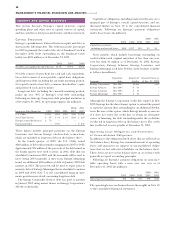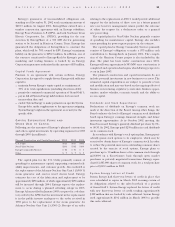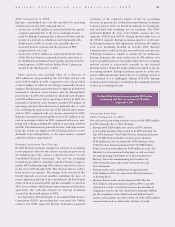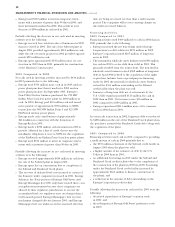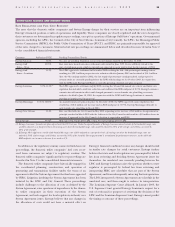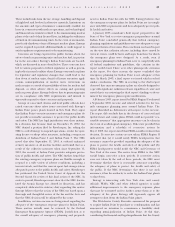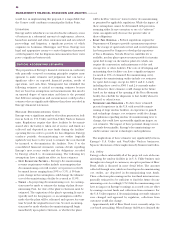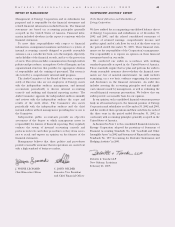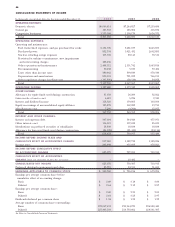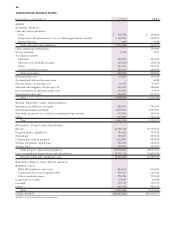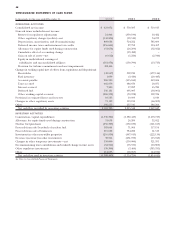Entergy 2002 Annual Report Download - page 40
Download and view the complete annual report
Please find page 40 of the 2002 Entergy annual report below. You can navigate through the pages in the report by either clicking on the pages listed below, or by using the keyword search tool below to find specific information within the annual report.
would face in implementing this proposal, it is improbable that
the County could condemn or municipalize Indian Point.
LITIGATION
Entergy and its subsidiaries are involved in the ordinary course
of business in a substantial amount of employment, asbestos,
hazardous material and other environmental and rate-related
proceedings and litigation, a significant portion of which
originates in Louisiana, Mississippi, and Texas. Entergy uses
legal and appropriate means to contest litigation threatened
or filed against it, but the litigation environment in these states
poses a significant business risk.
CRITICAL ACCOUNTING ESTIMATES
The preparation of Entergy’s financial statements in conformity
with generally accepted accounting principles requires man-
agement to make estimates and judgments that can have a
significant effect on reported financial position, results of
operations, and cash flows. Management has identified the
following estimates as critical accounting estimates because
they are based on assumptions and measurements that involve
an unusual degree of uncertainty, and there is the potential
that different assumptions and measurements could produce
estimates that are significantly different than those recorded in
Entergy’s financial statements.
NUCLEAR DECOMMISSIONING COSTS
Entergy owns a significant number of nuclear generation facil-
ities in both its U.S. Utility and Non-Utility Nuclear business
units. Regulations require that these facilities be decommis-
sioned after the facility is taken out of service, and funds are
collected and deposited in trust funds during the facilities’
operating lives in order to provide for this obligation. Entergy
conducts periodic decommissioning cost studies (typically
updated every three to five years) to estimate the costs that will
be incurred to decommission the facilities. Note 9 to the
consolidated financial statements contains details regarding
Entergy’s most recent studies and the obligations recorded
by Entergy related to decommissioning. The following key
assumptions have a significant effect on these estimates:
COST ESCALATION FACTORS –Entergy’s decommissioning
revenue requirement studies include an assumption that
decommissioning costs will escalate over present cost levels
by annual factors ranging from 3.0% to 5.5%. A 50 basis
point change in this assumption could change the ultimate
cost of decommissioning a facility by as much as 11.0%.
TIMING –In projecting decommissioning costs, two assump-
tions must be made to estimate the timing of plant decom-
missioning. First, the date of the plant’s retirement must be
estimated. The expiration of the plant’s operating license is
typically used for this purpose, or an assumption could be
made that the plant will be relicensed and operate for some
time beyond the original license term. Second, an assump-
tion must be made whether decommissioning will begin
immediately upon plant retirement, or whether the plant
will be held in “safestore” status for later decommissioning,
as permitted by applicable regulations. While the impact of
these assumptions cannot be determined with precision,
assuming either license extension or use of a “safestore”
status can significantly decrease the present value of
these obligations.
SPENT FUEL DISPOSAL –Federal regulations require the
Department of Energy to provide a permanent repository
for the storage of spent nuclear fuel, and recent legislation
has been passed by Congress to develop this repository
at Yucca Mountain, Nevada. However, until this site is
available, nuclear plant operators must provide for interim
spent fuel storage on the nuclear plant site, which can
require the construction and maintenance of dry cask
storage sites or other facilities. The costs of developing and
maintaining these facilities can have a significant impact
(as much as 16% of estimated decommissioning costs).
Entergy’s decommissioning studies include cost estimates
for spent fuel storage, except for ANO 1 and 2. A study
including these costs for ANO 1 and 2 is currently under-
way. However, these estimates could change in the future
based on the timing of the opening of the Yucca Mountain
facility, the schedule for shipments to that facility when it is
opened, or other factors.
TECHNOLOGY AND REGULATION –To date, there is limited
practical experience in the U.S. with actual decommis-
sioning of large nuclear facilities. As experience is gained
and technology changes, cost estimates could also change.
If regulations regarding nuclear decommissioning were to
change, this could have a potentially significant impact on
cost estimates. The impact of these potential changes is not
presently determinable. Entergy’s decommissioning cost
studies assume current technologies and regulations.
The implications of these estimates vary significantly between
Entergy’s U.S. Utility and Non-Utility Nuclear businesses.
Separate discussions of these implications by business unit follow.
U.S. Utility
Entergy collects substantially all of the projected costs of decom-
missioning the nuclear facilities in its U.S. Utility business unit
through rates charged to customers, except for portions of River
Bend, which is discussed in more detail below. The amounts
collected through rates, which are based upon decommissioning
cost studies, are deposited in decommissioning trust funds.
These collections plus earnings on the trust fund investments are
generally estimated to be sufficient to fund the future decom-
missioning costs. Accordingly, U.S. Utility decommissioning costs
have no impact on Entergy’s earnings, as accrued costs are offset
by earnings on trust funds and collections from customers. For
the U.S. Utility segment, if decommissioning cost study estimates
were changed and approved by regulators, collections from
customers would also change.
Approximately half of River Bend is not currently subject to
cost-based ratemaking. When Entergy Gulf States obtained the
MANAGEMENT’S FINANCIAL DISCUSSION AND ANALYSIS continued
38


